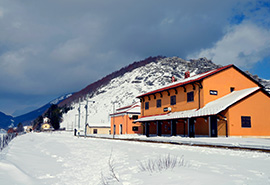The need to develop a transalpine railway line starts to come to the attention already before the unification of Italy. The need for this was dictated above all by reasons of a commercial nature, transporting raw materials and finished products in a faster manner would have certainly given a boost to manufacturing and commercial activities.
So in the Italian parliament began discussing routes such as the Pescara-Popoli-Rieti line and the Avezzano-Roma line. Politician Giuseppe Andrea Angeloni insisted until Abruzzo was connected at the north through the Aquila-Terni line, to Rome through the direct line Avezzano-Sulmona and to Naples with a new route that crossed the Sangro valley.
In March 1865 Angeloni forward a proposal for a line Sulmona-Isernia and looked for support in Raffaele Mezzanotte appointed minister of labor during the third government of Depretis. For several years, the idea of a railway line that passes through the area of the highlands remained cloudy but Angeloni pushed in every way until Sulmona, his constituency, became the central station of major railway routes.
In the spring of 1879, the Prime Minister Depretis reopens the question of the railways, on the 28th April, the debate was opened in Parliament on which routes to finance. The time was ripe for the great project of Angeloni and finally the law is enacted for the reorganization of the Italian railways, which states that the Roma-Sulmona line was classified in the first category and, therefore, to be built at the expense of the state. Also approved were the routes Avezzano-Roccasecca and Sulmona-Isernia.
The latter, which also touched the territory of the town of Palena, was inaugurated on the 18th September, 1897. This railway consturction was one of the most daring of the time due to having to go through mainly mountains, this is why the line is referred to as the Trans-Siberian railway of Italy, 129 km of track, 58 tunnels and over 100 bridges and viaducts.
The station of Palena is situated about 10km outside the town, in the area called 'Quarto di S. Chiara' closed for nearly a decade it had long been a place of transit of goods and passengers, as well as repair workshop for locomotives and wagons.
Some annual events bring the tracks to life, tourist trips are organized aiming to show the value of this railway line and its history.

The need to develop a transalpine railway line starts to come to the attention already before the unification of Italy. The need for this was dictated above all by reasons of a commercial nature, transporting raw materials and finished products in a faster manner would have certainly given a boost to manufacturing and commercial activities.
So in the Italian parliament began discussing routes such as the Pescara-Popoli-Rieti line and the Avezzano-Roma line. Politician Giuseppe Andrea Angeloni insisted until Abruzzo was connected at the north through the Aquila-Terni line, to Rome through the direct line Avezzano-Sulmona and to Naples with a new route that crossed the Sangro valley.
In March 1865 Angeloni forward a proposal for a line Sulmona-Isernia and looked for support in Raffaele Mezzanotte appointed minister of labor during the third government of Depretis. For several years, the idea of a railway line that passes through the area of the highlands remained cloudy but Angeloni pushed in every way until Sulmona, his constituency, became the central station of major railway routes.
In the spring of 1879, the Prime Minister Depretis reopens the question of the railways, on the 28th April, the debate was opened in Parliament on which routes to finance. The time was ripe for the great project of Angeloni and finally the law is enacted for the reorganization of the Italian railways, which states that the Roma-Sulmona line was classified in the first category and, therefore, to be built at the expense of the state. Also approved were the routes Avezzano-Roccasecca and Sulmona-Isernia.
The latter, which also touched the territory of the town of Palena, was inaugurated on the 18th September, 1897. This railway consturction was one of the most daring of the time due to having to go through mainly mountains, this is why the line is referred to as the Trans-Siberian railway of Italy, 129 km of track, 58 tunnels and over 100 bridges and viaducts.
The station of Palena is situated about 10km outside the town, in the area called 'Quarto di S. Chiara' closed for nearly a decade it had long been a place of transit of goods and passengers, as well as repair workshop for locomotives and wagons.
Some annual events bring the tracks to life, tourist trips are organized aiming to show the value of this railway line and its history.